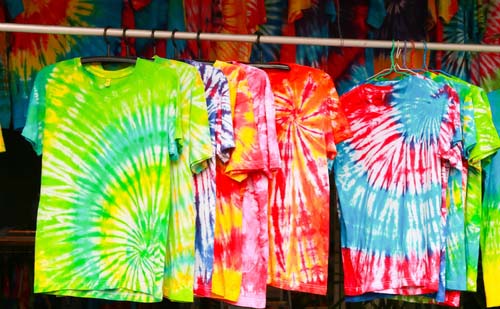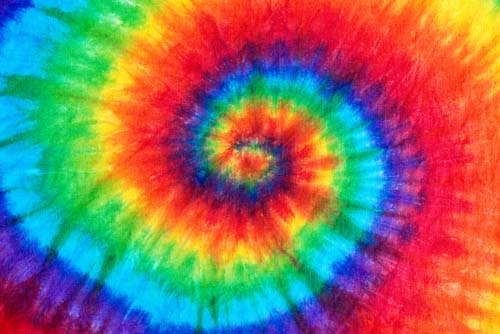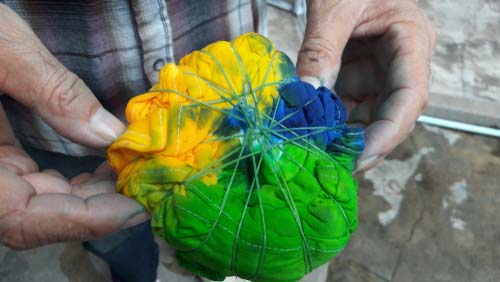3 Best Tie Dye Color Combos

Source: Jaochainoi1980/Shutterstock.com
Whether you are a newbie or a seasoned pro, one of the great things about tie dyeing is that there are no limits in terms of what you can create. From popular tie dye color combos in swirl patterns to unique pairings in one-of-a-kind designs, it is amazing just how many things you can create with bulk wholesale t-shirts, fabric dye, rubber bands and a bit of creativity.
Making Your Own Tie Dye? Check Out Our Wholesale Blank T-Shirts
As boredom ramped up during the early months of COVID restrictions, creativity surged. And, with tie dye making a big comeback in the fashion world, it is no surprise that lots of people have been using their newly found free time to make unique t-shirts, hoodies, tapestries and more.
If you are finding that your creations are looking more like Pinterest fails than vibrant masterpieces, though, you may not be combining the right colors. Before you dive into your next project, check out this guide to the best tie dye color combinations.
Understanding the Basics of Color Theory
As a beginner DIY tie-dyer, it can be helpful to understand color theory before you begin picking different colors for your project.
Color theory is a set of principles that explains how colors interact with each other. Understanding color theory is helpful when picking colors to tie dye a shirt because it allows you to create a harmonious color palette and achieve the desired look.
The color wheel is a visual representation of color theory and divides colors into primary and secondary colors. Primary colors include red, blue and yellow, creating secondary colors when mixed together. For example, combining blue and yellow creates green, while mixing red and yellow creates orange.
Color mixing is essential to color theory because it allows you to create new colors with different shades and hues. For example, you can make fuchsia, a bright, purplish-red color, by mixing blue and red with a larger proportion of red than blue. You can also create colors like teal by mixing one part blue with one part green and adjusting the proportions to achieve the desired shade of teal.
Complementary colors are opposite one another on the color wheel, such as blue and orange or red and green. When placed next to each other, complementary colors create a strong visual contrast that can be used to create striking tie-dye designs.
Understanding color theory and using the color wheel can help you select colors that work well together and create a cohesive and aesthetically pleasing tie-dye shirt. Likewise, it can help you avoid using colors that give your shirt a dull or clashing appearance.
Single Colors
If you are a complete tie-dye newbie, doing a few single-color designs is a great place to start. Instead of trying to figure out which colors look good together, you just need to add one color to the fabric. Despite what you may think, the results will be more chic than boring.
For this method, you can simply tie a white shirt and add a single color of dye. Or you can use your favorite color dye on a pastel shirt instead of white. Using magenta dye on a pastel pink tee, for example, would yield stunning results! Another option is using multiple shades of the same color – e.g., light blue, medium blue and dark blue. This is a great way to experiment with how tie dyeing works without the risk of creating muddy brown colors.
Two Colors
When you are ready to step up your game, try making tie-dye shirts with two colors. Remember, though, that when placed next to each other, they will mix slightly. For this reason, you need to be mindful of what colors you use. Consider watching helpful tutorials online to find inspiration and techniques for getting the right shade.
To create attractive two-color designs, you can use either two primary colors or one primary color plus one secondary color. Options for two primary colors include:
- Red + Yellow (Creates Orange)
- Red + Blue (Creates Purple)
- Blue + Yellow (Creates Green)
To combine a primary and secondary color, try:
- Red + Purple (Creates Burgundy)
- Blue + Pink (Creates Purple)
- Green + Yellow (Creates Bright Green)
There are also a few color combos to avoid:
- Blue + Orange
- Yellow + Purple
- Red + Green
These combinations create brown, which generally is not a color you want to make when doing tie dye. There’s no accounting for tastes, so try out a few and see how they sell.
Rainbow

Source: P-fotography/Shutterstock.com
Is there a more quintessential tie-dye combo than a rainbow? We don’t think so! Whether you make your rainbow neon, pastel or something in between, it is hard to go wrong with this color scheme.
One thing to keep in mind, though, is that you will get the best results if you apply the colors in the same order as a real rainbow. Making sure your colors are arranged in the proper order – red, orange, yellow, green, blue, indigo, violet – means you do not have to worry about two colors that clash being next to each other.
Tie Dye Tips

Source: HACHI STUDIO/Shutterstock.com
If you want to create bright, vibrant designs, working with fabric made from natural fibers is best. Natural fibers – especially cotton – readily absorb color and yield impressive results.
Damp fabric absorbs color better than dry fabric, too, so make sure your shirt or any other item is damp before folding and tying. Consider pre-soaking your t-shirts in a soda ash solution made by mixing one gallon of warm water with one cup of soda ash. The alkaline solution helps the dye bind to the fabric fibers more effectively and minimizes color bleeding, allowing you to try multiple color combinations on a single shirt. It also helps keep bolder jewel tones like teal and fuchsia from fading into pastels after washing.
Choose dyes that are appropriate for your project. This is especially important if you are dying something that is not made from natural fiber. Special dyes may be needed to dye polyester and other synthetic fabrics. It is always a good idea to test your dye colors, too. Squeezing a bit out on a paper towel will give you a better feel for what the color looks like and how vibrant it is. Remember, though, that the color will always be a bit less intense after rinsing.
You could also try using tie-dye kits. The kits usually contain everything you need to get started, including dye, gloves, rubber bands and instructions. They allow you to experiment with different color combinations, tie-dye patterns, techniques and designs to create a one-of-a-kind t-shirt.
Another great way to experiment with color is to try the ice dye technique. This method allows you to use multiple colors simultaneously without worrying about color bleeding. The technique uses blocks of ice placed strategically on the t-shirt, and sprinkling powdered dye on top, creating an alluring watercolor effect.
Last, make sure you know how to wash a tie-dye shirt. This is a vital step in ensuring that your creations will withstand the test of time!
Shop Blank T-Shirts for Tie Dyeing at The Adair Group
At The Adair Group, we have blank white t-shirts that are perfect for tie dye. We also stock premade tie-dyed shirts for anyone who wants to embrace the trend without getting their hands dirty. Shop our full collection today!


